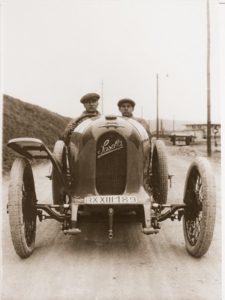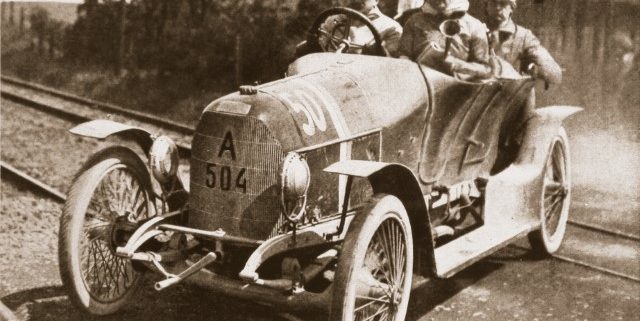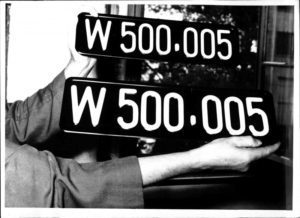The first motor vehicle registration plates – A history of Austrian licence plates
Even when hackney carriages were still the only means of inner-city transport, an ordinance from 1756 stipulated number plates for these horse teams – for a better situational overview. The so-called „unnumbered“ were an exception. In Vienna, it was considered particularly genteel to drive such an unnumbered carriage.
„identification mark“ / licence plate for automobiles and motorcycles
From an international perspective, the legal basis of registration plating automobiles and motorcycles in Austria was established relatively late. With a „Regulation of the Ministry of the Interior in agreement with the Ministry of Finance of 27 September, 1905 concerning the enactment of security police regulations for the operation of automobiles and motorcycles“, identification plates for motor vehicles were prescribed from 7 January 1906 for the entire Austrian sector of the dual monarchy. The Hungarian half of the empire followed only in 1910. By comparison: in Switzerland, Italy, France, England, Holland and most of the federal states of the then German Empire, registration numbers were already mandatory in the years after 1899. One reason for the late introduction of number plate obligation in Austria was the resistance of the „gentlemen drivers“ who found it shameful to have their cars numbered like carriages and to be monitored by the authorities. On the other hand, the Austrian Automobile Club – predecessor of today’s ÖAMTC – regarded the marking as very important, especially in order to locate hit and run drivers … and prevailed.
From 7 January, 1906, the „identification mark“ (the term „licence plate“ was not used until 1910) had to be affixed to the front and rear of a car or motorcycle in black lettering on a white background – either painted on or on a plate. Each Crown country as well as the police districts of Vienna and Prague were assigned a code letter – without direct connection to the country name/initial:

In the picture: ADS-R Sascha race car with Alfred Neubauer and Georg Auer in Wiener Neustadt (1922).
- A – Vienna
- B – Lower Austria without Vienna,
- C – Upper Austria
- D – Salzburg
- E– Tyrol
- F – Carinthia
- H – Styria
- J – Carniola
- K – coastal country
- M – Dalmatia
- N – Prague
- O – Bohemia without Prague
- P – Moravia
- R – Silesia
- S – Galicia
- T – Bucovina
- W – Vorarlberg.
This was followed by the registration number – Arabic numerals between 1 and 999. After the Arabic numeral stock had been depleted, Roman numerals were inserted between the identification letters and the registration number, which soon made the legibility of the number plates very unclear (e.g. A 20, BIV 37, BXII 908). The first and lowest registration numbers were assigned to the high nobility. The very first registration with the number A1 was assigned to Archduke Eugen in Vienna on 7 January, 1906.
White font on black background
The first change to the number plates took place with the ordinance of 12 May, 1930, in which not only the colours of the number plates were changed according to the British model to white lettering on a black background, but also the system of numbering to country code and then a maximum six-digit number from which the registering authority could be identified (e.g. A 2.170).
With the Anschluss of Austria into the German Reich, the German plates with new identification letters were used from 1939 to 1947, e.g. „W“ for Vienna, „Nd“ for Lower Danube (Lower Austria).
After the end of WWII, the „Kraftfahrverordnung/ motor vehicle ordinance 1947“, an ordinance from 1937, was reissued. The license plates were now written in white lettering on a black background. The federal states and the cities now received the initial letters of their names:
- B – Burgenland
- K – Carinthia (Kärnten)
- N – Lower Austria (Niederösterreich)
- O – Upper Austria (Oberösterreich)
- S – Salzburg
- St – Styria
- T – Tyrol
- V – Vorarlberg
- W – Vienna (Wien).
The provincial capitals Graz – G and Linz – L even received their own code letters.
From 1988 onwards, there were many discussions about colours and visibility – including, inter alia, with the artist Friedensreich Hundertwasser, who advocated the retention of the previous white lettering on a black background. Nevertheless, a new decision was made on January 1, 1990: the license plates now had to have black writing on a white (reflective) background, double red lines (Austrian national colours) at the top and bottom for reasons of national identity, and the respective Austrian state coat of arms in colour (slightly raised) between the place-name code and the number.
Quellen
Austria-forum.org, Kulturwandel durch Technik / Geschichte des Autos
Fahrzeugindustrie.at, 100 Jahre Fahrzeugindustrie / Autoland Österreich
Seper, H.(1986): Österreichische Automobilgeschichte, Orac Verlag.
Technisches Museum Wien (2006): Spurwechsel. Wien lernt Auto fahren, Christian Brandstätter Verlag.
Wikipedia, Historische Kfz-Kennzeichen
Geschichtewiki.wien.gv.at, Kraftfahrzeugkennzeichen
Bildnachweis
Bild 1: fahr(T)raum Archiv, Graf Orssich and passanger with signal horn at the Prinz-Heinrich-Fahrt 1910,with arched radiator. They finished 49th.
Bild 2: fahr(T)raum Archiv, test drive with the ADS-R race car in Wiener Neustadt, 1922
Bild 3: License plate number 500.005, in two different formats, close up © ÖNB , FO400697/03
You might also be interested in:








New exhibit at fahr(T)raum – 1916 Austro Daimler 2-cylinder Feldbahn engine
/v Geschichte, Motoren, Uncategorized @csField and industrial railways (Feldbahnen) have assisted the transport of agricultural, forestry and industrial raw materials and products since the 19th century. They offered high transport performance with simultaneous low energy consumption (low rolling resistance of the wheel-rail system). Their use is mainly associated with the processing industry, such as, e.g., chamotte or sugar factories […]
Ferdinand Porsche and his tractors
/v Geschichte, Sonderausstellung, Traktoren, Uncategorized @csFrom the „Daimler horse“ to the „System Porsche“ diesel tractor As a „universal technical genius“, Ferdinand Porsche addressed not only the development of sports cars, but all mechanical constructions for locomotion. Thus, he also played a major role in the motorisation of agriculture. Porsche developed the so-called „Daimler horse“ for Austro-Daimler right after the beginning […]
Austro-Daimler Maja 28/32 celebrates its 110th birthday
/v Geschichte, Motoren, Rennautos, Uncategorized @cs110 years have passed since Ferdinand Porsche developed the first purely petrol-driven car for Austro-Daimler – the AD Maja 28/32. In September 1906, Emil Jellinek, head of the Austro-Daimler company, brought in Ferdinand Porsche to Daimler in Wiener Neustadt as a new development manager and technical director for the construction of AD Maja. After only […]